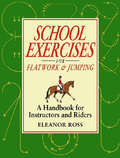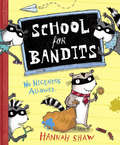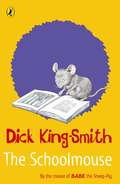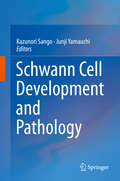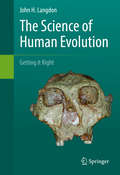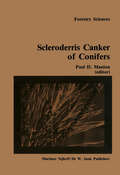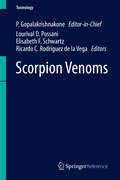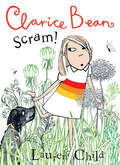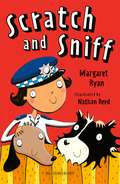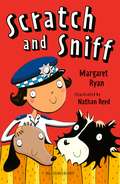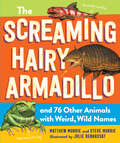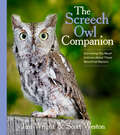- Table View
- List View
SCHOOL EXERCISES FOR FLATWORK AND JUMPING: A Handbook For Instructors And Riders
by ELEANOR ROSSThis volume offers ideas and specimen exercises for trainee instructors and more experienced instructors, and for riders schooling their own horses or ponies, and aims to provide purpose, variety and interest to lessons and riding sessions, for teachers, horses and riders.
School for Bandits
by Hannah ShawMr and Mrs Raccoon are terribly worried about their son Ralph. He looks like all the other raccoons, but his behaviour is just awful: he's polite, thoughful, kind and he even says please and thank you!It's time to send Ralph to the School for Bandits, where he can learn to be bad. But perhaps Ralph has a thing or two to teach his classmates.
The Schoolmouse
by Dick King-SmithA wonderful animal adventure from master storyteller, Dick King-Smith.Flora was born on the first day of term in the new school year, which might be why she's a very special mouse indeed - a mouse who has taught herself to read!Flora lives in a classroom, and is determined to learn all sorts of things that no mouse has ever learned before. Her family is horrified at first, but then Flora's reading saves their lives ...
Schutzfermente des tierischen Organismus: Ein Beitrag zur Kenntnis der Abwehrmaßregeln des tierischen Organismus gegen körper-, blut- und zellfremde Stoffe
by Emil AbderhaldenDieser Buchtitel ist Teil des Digitalisierungsprojekts Springer Book Archives mit Publikationen, die seit den Anfängen des Verlags von 1842 erschienen sind. Der Verlag stellt mit diesem Archiv Quellen für die historische wie auch die disziplingeschichtliche Forschung zur Verfügung, die jeweils im historischen Kontext betrachtet werden müssen. Dieser Titel erschien in der Zeit vor 1945 und wird daher in seiner zeittypischen politisch-ideologischen Ausrichtung vom Verlag nicht beworben.
Schwann Cell Development and Pathology
by Kazunori Sango Junji YamauchiThis book presents recent topics on the development, differentiation, and myelination of Schwann cells, as well as pathological mechanisms and therapeutic approaches for peripheral neuropathies, such as Charcot–Marie–Tooth diseases, amyloid polyneuropathy, immune-mediated neuropathy and diabetic neuropathy. The rapid progress of molecular biological techniques in the last decades, especially for RNA techniques and gene modification technologies have allowed us to investigate the pathobiology of Schwann cells in vivo and in vitro. Studies combining recent stem cell biology with recent biotechnology, which is now closely linked to physicochemical fields, further explain how Schwann cell lineages develop a process that has long been thought to be very complicated in vivo. The findings contribute to the elucidation of fundamental mechanisms during development and under pathological conditions. We now know that these are closely tied to each other. This book also introduces unique coculture systems to reproduce the neuron–Schwann cell interplay during development, degeneration, and regeneration. Up-to-date research topics with high-quality immunofluorescence and electron micrographs introduced by young and energetic contributors are sure to arouse the readers' interest in Schwann cell biology. Discussion from the viewpoint of basic and clinical neuroscience makes the book educational for researchers, medical students and young clinicians.
Schwarmintelligenz
by Heiko HamannDieses Buch veranschaulicht mithilfe mathematischer Modelle, wie man die kollektive Intelligenz natürlicher Systeme untersucht und anschließend in intelligente Algorithmen und Roboterschwärme übersetzt. Menschen nutzen Tiere seit Jahrtausenden zur Unterstützung ihrer Arbeiten und dies wird sich auch in der Zukunft nicht ändern: Anstelle der lebenden Tiere werden es jedoch ihre Intelligenzleistungen und Kommunikationsstrategien sein, die unsere modernen Leben immer mehr beeinflussen. Heiko Hamann begeistert mit seiner Faszination für die Leistungen tierischer und menschlicher Gesellschaften. In einfachen Beispielen und in eleganter, präziser und einfach verständlicher Weise erklärt er diese Systeme und ihren Inspirationsursprung.
The Science of Human Evolution: Getting it Right
by John H. LangdonThis textbook provides a collection of case studies in paleoanthropology demonstrating the method and limitations of science. These cases introduce the reader to various problems and illustrate how they have been addressed historically. The various topics selected represent important corrections in the field, some critical breakthroughs, models of good reasoning and experimental design, and important ideas emerging from normal science.
The Science of Meat Quality
by Chris R. KerthMeat has been a long sought after source of nutrients in human diets. Its nutrient-dense composition of protein, fats, vitamins and minerals makes it an integral part to healthy and balanced diets. As demand for meat continues to increase globally, a better understanding of efficiently producing quality meat products is becoming increasingly important. The Science of Meat Quality provides comprehensive coverage of meat quality from the biological basis of muscle development to end-product-use topics such as preparation and sensory analysis. The Science of Meat Quality explores the basis of meat quality long before it hits grocery store shelves. The book opens with a look at cellular muscle tissue development, metabolism and physiology. Subsequent chapters look at topics surrounding the development of tenderness, water-holding capacity, lipid oxidation and color in meat products. The final chapters discuss producing a good-tasting end product from preparing meat to preventing food-borne illness. Each chapter contains not only the theory behind that topic, but also detailed lab methodologies for measuring each meat quality trait. The Science of Meat Quality is an essential resource and reference for animal scientists, meat scientists, food scientists, and food industry personnel. Meat has been a long sought after source of nutrients in human diets. Its nutrient-dense composition of protein, fats, vitamins and minerals makes it an integral part to healthy and balanced diets. As demand for meat continues to increase globally, a better understanding of efficiently producing quality meat products is becoming increasingly important. The Science of Meat Quality provides comprehensive coverage of meat quality from the biological basis of muscle development to end-product-use topics such as preparation and sensory analysis. The Science of Meat Quality explores the basis of meat quality long before it hits grocery store shelves. The book opens with a look at cellular muscle tissue development, metabolism and physiology. Subsequent chapters look at topics surrounding the development of tenderness, water-holding capacity, lipid oxidation and color in meat products. The final chapters discuss producing a good-tasting end product from preparing meat to preventing food-borne illness. Each chapter contains not only the theory behind that topic, but also detailed lab methodologies for measuring each meat quality trait. The Science of Meat Quality is an essential resource and reference for animal scientists, meat scientists, food scientists, and food industry personnel.
The Science of Meat Quality
by Chris R. KerthMeat has been a long sought after source of nutrients in human diets. Its nutrient-dense composition of protein, fats, vitamins and minerals makes it an integral part to healthy and balanced diets. As demand for meat continues to increase globally, a better understanding of efficiently producing quality meat products is becoming increasingly important. The Science of Meat Quality provides comprehensive coverage of meat quality from the biological basis of muscle development to end-product-use topics such as preparation and sensory analysis. The Science of Meat Quality explores the basis of meat quality long before it hits grocery store shelves. The book opens with a look at cellular muscle tissue development, metabolism and physiology. Subsequent chapters look at topics surrounding the development of tenderness, water-holding capacity, lipid oxidation and color in meat products. The final chapters discuss producing a good-tasting end product from preparing meat to preventing food-borne illness. Each chapter contains not only the theory behind that topic, but also detailed lab methodologies for measuring each meat quality trait. The Science of Meat Quality is an essential resource and reference for animal scientists, meat scientists, food scientists, and food industry personnel. Meat has been a long sought after source of nutrients in human diets. Its nutrient-dense composition of protein, fats, vitamins and minerals makes it an integral part to healthy and balanced diets. As demand for meat continues to increase globally, a better understanding of efficiently producing quality meat products is becoming increasingly important. The Science of Meat Quality provides comprehensive coverage of meat quality from the biological basis of muscle development to end-product-use topics such as preparation and sensory analysis. The Science of Meat Quality explores the basis of meat quality long before it hits grocery store shelves. The book opens with a look at cellular muscle tissue development, metabolism and physiology. Subsequent chapters look at topics surrounding the development of tenderness, water-holding capacity, lipid oxidation and color in meat products. The final chapters discuss producing a good-tasting end product from preparing meat to preventing food-borne illness. Each chapter contains not only the theory behind that topic, but also detailed lab methodologies for measuring each meat quality trait. The Science of Meat Quality is an essential resource and reference for animal scientists, meat scientists, food scientists, and food industry personnel.
The Science of Photobiology
by Kendric C. SmithThe first edition of The Science of Photobiology was published in 1977, and was the first textbook to cover all of the major areas of photobiology. The science of photobiology is currently divided into 14 subspecialty areas by the American Society for Photobiology. In this edition, however, the topics of phototechnology and spectroscopy have been com bined in a new chapter entitled "Photophysics." The other subspecialty areas remain the same, i.e., Photochemistry, Photosensitization, UV Radiation Effects, Environmental Photobiology, Photomedicine, Circadian Rhythms, Extraretinal Photoreception, Vision, Photomorphogenesis, Photomovement, Photosynthesis, and Bioluminescence. This book has been written as a textbook to introduce the science of photobiology to advanced undergraduate and graduate students. The chapters are written to provide a broad overview of each topic. They are designed to contain the amount of information that might be presented in a one-to two-hour general lecture. The references are not meant to be exhaustive, but key references are included to give students an entry into the literature. Frequently a more recent reference that reviews the literature will be cited rather than the first paper by the author making the original discovery. The chapters are not meant to be a repository of facts for research workers in the field, but rather are concerned with demon strating the importance of each specialty area of photobiology, and documenting its relevance to current and/or future problems of man.
Science of Vision
by K. Nicholas LeibovicConverging lines of biological, perceptual and theoretical approaches are brought together in The Science of Vision to give a new perspective on the brain sciences and vision in particular. The book contains contributions from experts in the fields of biophysics, physiology, psychology and computation. While reviewing some basic knowledge, it mainly presents fresh ideas and includes some new results. The topics range from cells through perception to neurocomputing and are treated in depth, taking the specialist to the frontiers of research. At the same time the book is written in a manner understandable to the nonspecialist, in keeping with the multidisciplinary appeal of the subject. A glossary of terms also makes the book easy to read. In our age of specialization, this integrated approach is a welcome addition to the literature which will further interdisciplinary research and shed new light on the vision sciences.
The Sciences of Animal Welfare
by David Mellor Emily Patterson-Kane Kevin J. StaffordThe Sciences of Animal Welfare analyses the diverse, interconnecting subjects which constitute this fascinating multidisciplinary field, whilst also considering the limitations and benefits of those subjects to the development and future of Animal Welfare Science. This book examines past, present and future practices and thinking, including the wide-ranging interests within society that influence attitudes towards animals and conversely how animal welfare scientists may influence those attitudes. Key themes of the book include: • Multi-disciplinary working and its benefits: how we can obtain fresh insights, enliven our thinking and improve animal welfare by operating widely within diverse disciplines • Questioning the fundamental assumptions we each make about animals and their functional capabilities. The authors acknowledge the field’s debt to past successes in animal-based science disciplines, successes that markedly improved animal welfare long before the concept of animal welfare entered common parlance. They also recognise the problems which unexpectedly arose, and anticipate future successes. Suggesting innovative approaches to Animal Welfare Science, and written by world renowned experts, The Sciences of Animal Welfare is essential reading for anyone interested, studying or currently working in Animal Welfare Science. This book is part of the UFAW/Wiley-Blackwell Animal Welfare Book Series. This major series of books produced in collaboration between UFAW (The Universities Federation for Animal Welfare), and Wiley-Blackwell provides an authoritative source of information on worldwide developments, current thinking and best practice in the field of animal welfare science and technology. For details of all of the titles in the series see www.wiley.com/go/ufaw.
A Scientific Approach to Improving Animal Research in Biomedicine: Giving Animals a Chance
by Bradley K. WeinerThis book examines animal research conducted with the goal of medical translation to humans. It is written by Dr. Bradley Weiner, a surgeon who is active at a high level clinically and in biomedical research. After documenting that the vast majority of biomedical animal research fails to result in benefits to humans via translation, the book examines the sources of such failure; including the failure to justify the use of animals, the failure to properly apply scientific methods, the failure to perform the research properly in the lab, the failure to consider the possibility of translation a priori, and systematic sources of failure built into the biomedical research enterprise. The book then explores options to improve the situation, for the benefit of both the animals and humans.
Scleroderris canker of conifers: Proceedings of an international symposium on scleroderris canker of conifers, held in Syracuse, USA, June 21–24, 1983 (Forestry Sciences #13)
by P. D. ManionThe "International Symposium on Scleroderris Canker of Conifers" held June 21-24, 1983 in Syracuse, New York was the result of mutual interest expressed by the USDA Forest Service, the Canadian Forestry Service, and the State Uni versity of New York College of Environmental Science and Forestry (SUNY ESF). The Symposium was an official function of the working party canker diseases (Scleroderris), Subject group S.2.06.02 Division II IUFRO. We wish to express our thanks to the USDA Forest Service, Research and the Canadian Forestry Service for financial support of the program, and SUNY ESF for hosting the Symposium. A major research program was launched in 1977 to study the biology of the European strain as found in North America. Support for this research resulted from spec i a 1 fund ing by the Congress of the United States to the USDA Forest Service, North Central Forest Experiment Station. Most of these funds were released as cooperative research grants to universities in the Lake States and the northeast. Many of the research papers delivered at this Symposium are the direct result of these research grants. While the Symposium deliberately emphasized the North American experience 'with Gremmeniella abietina in order to provide a focus for the meeting, we were anxious that this Symposium would also include studies from other countries.
Scorpion (Large Print)
This image of a scorpion is viewed from above, with the scorpion facing up the page. There is a locator dot shown, which will be at the top left of the page when the image is the right way up. At the top of the page are its two huge pincer-like claws (pedipalps), which connect to either side of the upper body (cephalothorax) close to the two mouth parts and six eyes. Its body runs down the centre of the page, with four segmented legs on each side. Continuing on from the body, the scorpion's long tail curves down to the left and round to end in a pointed stinger.
Scorpion (UEB Contracted)
This image of a scorpion is viewed from above, with the scorpion facing up the page. There is a locator dot shown, which will be at the top left of the page when the image is the right way up. At the top of the page are its two huge pincer-like claws (pedipalps), which connect to either side of the upper body (cephalothorax) close to the two mouth parts and six eyes. Its body runs down the centre of the page, with four segmented legs on each side. Continuing on from the body, the scorpion's long tail curves down to the left and round to end in a pointed stinger.
Scorpion (UEB Uncontracted)
This image of a scorpion is viewed from above, with the scorpion facing up the page. There is a locator dot shown, which will be at the top left of the page when the image is the right way up. At the top of the page are its two huge pincer-like claws (pedipalps), which connect to either side of the upper body (cephalothorax) close to the two mouth parts and six eyes. Its body runs down the centre of the page, with four segmented legs on each side. Continuing on from the body, the scorpion's long tail curves down to the left and round to end in a pointed stinger.
Scorpion Venoms (Toxinology Ser. #4)
by P. Gopalakrishnakone, Lourival D. Possani, Elisabeth F. Schwartz and Ricardo C. Rodríguez de la VegaScottish Mammals
by Robin HullScotland is a treasure-chest of natural history, but it also offers a wealth of wonderful literature about its wild creatures. Delving into Robin Hull's own experience of the mammals in Scotland and drawing on the texts of many of the great Scottish natural history writers, this book, the first of its kind, examines the historical and cultural relationship between humans and mammals in Scotland over the last 10,000 years. All the wild mammalian species of Scotland are covered, including marine mammals which have been sighted in Scottish waters, such as walruses and narwhals. Insightful and meticulously researched, "The History of Scottish Mammals" is an analysis of the impact of humans on the planet, as well as a riveting study of the facts and fictions associated with mammals in Scotland.
Scram! (Clarice Bean)
by Lauren ChildThe exceptionordinary, effervescent Clarice Bean is back with her trademark heart and humour in this beautifully illustrated story by former Children’s Laureate Lauren Child – a delightful summer read for the entire family!
Scratch and Sniff: A Bloomsbury Reader (Bloomsbury Readers)
by Margaret RyanA cops and robbers adventure with a twist by children's writer Margaret Ryan. PC Penny Penrose is always given the rotten jobs to do by Sergeant Snide. She never gets to see any of the real police action. When there's a robbery at Doogood's department store, Penny is left behind to count traffic cones. Until, that is, her pet dog duo Scratch and Sniff decide to help out!This humorous story from Margaret Ryan has fun black-and-white illustrations by Nathan Reed and is perfect for children who are developing as readers.The Bloomsbury Readers series is packed with brilliant books to get children reading independently in Key Stage 2, with book-banded stories by award-winning authors like double Carnegie Medal winner Geraldine McCaughrean and Waterstones Prize winner Patrice Lawrence covering a wide range of genres and topics. With charming illustrations, ideas for discussion points and online guided reading notes written by the Centre for Literacy in Primary Education (CLPE), this series is ideal for reading both in the classroom and at home. For more information visit www.bloomsburyguidedreading.com.'Patrice Lawrence, Tony Bradman, Margaret Mahy [...] any list that brings together such a quality line up of authors is going to be welcomed.' - Books for Keeps on the seriesBook Band: Lime (Ideal for ages 7+)
Scratch and Sniff: A Bloomsbury Reader (Bloomsbury Readers)
by Margaret RyanA cops and robbers adventure with a twist by children's writer Margaret Ryan. PC Penny Penrose is always given the rotten jobs to do by Sergeant Snide. She never gets to see any of the real police action. When there's a robbery at Doogood's department store, Penny is left behind to count traffic cones. Until, that is, her pet dog duo Scratch and Sniff decide to help out!This humorous story from Margaret Ryan has fun black-and-white illustrations by Nathan Reed and is perfect for children who are developing as readers.The Bloomsbury Readers series is packed with brilliant books to get children reading independently in Key Stage 2, with book-banded stories by award-winning authors like double Carnegie Medal winner Geraldine McCaughrean and Waterstones Prize winner Patrice Lawrence covering a wide range of genres and topics. With charming illustrations, ideas for discussion points and online guided reading notes written by the Centre for Literacy in Primary Education (CLPE), this series is ideal for reading both in the classroom and at home. For more information visit www.bloomsburyguidedreading.com.'Patrice Lawrence, Tony Bradman, Margaret Mahy [...] any list that brings together such a quality line up of authors is going to be welcomed.' - Books for Keeps on the seriesBook Band: Lime (Ideal for ages 7+)
The Screaming Hairy Armadillo and 76 Other Animals with Weird, Wild Names
by Matthew Murrie Steve MurrieAn illustrated compendium of animals with funny, fascinating, or just-plain-weird names (like the sparklemuffin peacock spider or the fried egg jellyfish) teaches kids about unusual animals as well as scientific taxonomy. Genuinely fun reference!
The Screech Owl Companion: Everything You Need to Know about These Beneficial Raptors
by Jim Wright Scott WestonThis must-read for birders features a complete guide to attracting, understanding, and protecting owls. The call of an owl evokes mystery; seeing one in the wild inspires wonder. Of the top ten birds people hope to see, three are owls. Although they may be out of sight, owls are widespread throughout North America—and screech owls are the most likely to make their homes near humans. In this book, experts Jim Wright and Scott Weston show you how to attract them to nest in your yard, year after year.The Screech Owl Companion introduces screech owls, show how to distinguish them from other species, shares fun lore and legend, and provides step-by-step instructions for making your yard screech ready. You&’ll learn how to build a nest box and install a simple nest cam that you can monitor from your cell phone to watch when owls move in, lay eggs, and hatch.
